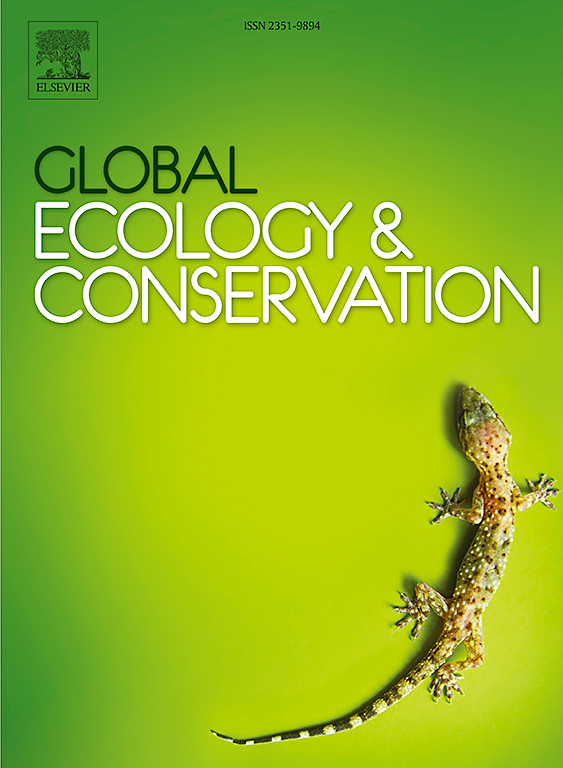Unveiling the potential of eDNA/eRNA approaches for monitoring the critically endangered Yangtze finless porpoise
IF 3.4
2区 环境科学与生态学
Q1 BIODIVERSITY CONSERVATION
引用次数: 0
Abstract
Assessing the population distribution and dynamics of the critically endangered Yangtze finless porpoise (Neophocaena asiaeorientalis) is essential for informing conservation strategies. Traditional monitoring techniques, while valuable, are labor-intensive and time-consuming. Environmental nucleic acids (eNAs) offer a non-invasive alternative, yet prior research has predominantly relied on single-locus eDNA analysis, limiting resolution. Here, we developed a dual-marker eDNA/eRNA approach targeting mitochondrial COX3 (Cytochrome C Oxidase subunit 3) and CYTB (Cytochrome B) genes, coupled with droplet digital PCR (ddPCR) quantification, to enhance detection sensitivity and reliability. Serial dilution experiments established stringent detection limits (LOD: 0.076 copies/μL; LOQ: 0.35 copies/μL), while degradation trials at the Tongling ex situ conservation site revealed eDNA persistence for 65.24 (COX3) and 50.13 (CYTB) hours, compared to rapid eRNA degradation (∼30 hours). Field surveys across 20 Yangtze River Estuary locations detected porpoise eDNA at 13 sites and eRNA at 11 sites, with 5 sites showing concurrent detection via both markers—predominantly near the Dongfeng Xisha Reservoir. Detection zones overlapped significantly with passive acoustic monitoring records, yet eNAs revealed broader spatial coverage. Our findings demonstrate that multi-locus eNA analysis provides a sensitive, scalable tool for monitoring critically endangered aquatic species, offering actionable insights to optimize conservation efforts.
揭示eDNA/eRNA方法监测极度濒危长江江豚的潜力
评估极度濒危长江江豚的种群分布和动态对制定保护策略至关重要。传统的监测技术虽然有价值,但需要耗费大量的人力和时间。环境核酸(eNAs)提供了一种非侵入性的替代方法,但之前的研究主要依赖于单位点eDNA分析,限制了分辨率。在这里,我们开发了一种针对线粒体COX3(细胞色素C氧化酶亚基3)和CYTB(细胞色素B)基因的双标记eDNA/eRNA方法,结合液滴数字PCR (ddPCR)定量,以提高检测的灵敏度和可靠性。串联稀释实验建立了严格的检出限(LOD: 0.076 copies/μL;LOQ: 0.35拷贝/μL),而在铜林迁地保护位点的降解试验显示,与eRNA的快速降解(~ 30 小时)相比,eDNA的持续时间为65.24 (COX3)和50.13 (CYTB)小时。在长江口20个地点的野外调查中,13个地点检测到江豚eDNA, 11个地点检测到eRNA,其中5个地点同时检测到这两种标记,主要是在东风西沙水库附近。探测区域与被动声监测记录有明显重叠,但eNAs显示了更广泛的空间覆盖范围。我们的研究结果表明,多位点eNA分析为监测极度濒危水生物种提供了一个敏感的、可扩展的工具,为优化保护工作提供了可操作的见解。
本文章由计算机程序翻译,如有差异,请以英文原文为准。
求助全文
约1分钟内获得全文
求助全文
来源期刊

Global Ecology and Conservation
Agricultural and Biological Sciences-Ecology, Evolution, Behavior and Systematics
CiteScore
8.10
自引率
5.00%
发文量
346
审稿时长
83 days
期刊介绍:
Global Ecology and Conservation is a peer-reviewed, open-access journal covering all sub-disciplines of ecological and conservation science: from theory to practice, from molecules to ecosystems, from regional to global. The fields covered include: organismal, population, community, and ecosystem ecology; physiological, evolutionary, and behavioral ecology; and conservation science.
 求助内容:
求助内容: 应助结果提醒方式:
应助结果提醒方式:


